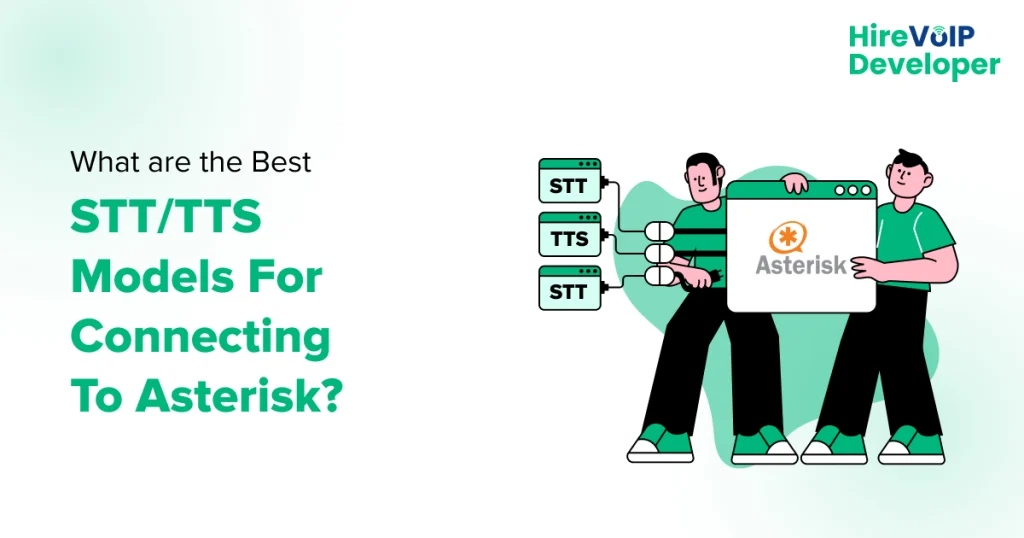📝 Quick Summary
Unlock seamless integration with Asterisk using cutting-edge Speech-to-Text (STT) and Text-to-Speech (TTS) models. Elevate your communication infrastructure effortlessly with our top recommendations for enhanced accessibility and performance.
Modern communication systems combine many different technologies and have produced flexible tools that enhance our interactions with computers and other machines. Integrating robust Speech-to-Text (STT) and Text-to-Speech (TTS) models into your Asterisk systems can significantly enhance user interaction and operational efficiency. Understanding which STT/TTS models best connect with Asterisk is essential to modernizing your communication frameworks.
This blog will guide you through selecting the top STT/TTS models, ensuring your setup is advanced and user-friendly.
Asterisk Speech-to-Text (STT)
Speech-to-text technology transforms spoken language into written text, which is immensely beneficial for voice mail transcription and real-time customer support applications. The key to integrating STT with Asterisk development is choosing models that provide high accuracy and ensure low latency for a better user experience.
Best Speech Recognition Models for Asterisk Integration
- Google Cloud Speech-to-Text: This model stands out due to its high accuracy rates, even in noisy environments, which makes it exceptionally reliable for business communications. Google’s STT supports over 120 languages and variants, allowing for broad application in diverse locations. Additionally, its ability to integrate with other Google services provides a cohesive ecosystem for developers.
- IBM Watson Speech to Text: IBM’s technology excels in offering cognitive recognition features, which are essential for understanding context and nuances within speech. Watson allows the creation of custom models tailored to recognize specific terminology relevant to your business sector, thus increasing its effectiveness. The model also supports real-time speech recognition for Asterisk, which is crucial for interactive systems like Asterisk.
- Microsoft Azure Speech to Text: Known for its robust framework in cloud computing, Azure’s STT service provides real-time and batch speech recognition capabilities. Its advantage lies in integrating with Microsoft’s cognitive services, making it a potent tool for creating intelligent, context-aware telephony solutions.
- Deepgram Speech Recognition: Deepgram offers a unique STT solution powered by deep learning technology. It provides real-time transcription, keyword spotting, and multiple language support. Deepgram’s API is easy to integrate with Asterisk and is scalable to accommodate high volumes of voice traffic, making it suitable for small and large businesses.
Asterisk Text-to-Speech (TTS)
Text-to-speech technology reads out text as spoken words, which is pivotal for interactions requiring verbal responses, such as automated customer service lines. In TTS technology, the clarity and naturalness of the voice are crucial.
Top Text-to-Speech Models for Effective Communication
- Amazon Polly: Amazon Polly delivers lifelike speech quality and includes a broad selection of voices and languages, making it highly adaptable for international use. Its neural network TTS technology ensures the output speech is natural-sounding and capable of expressing emotions, which is suitable for dynamic customer interactions.
- Microsoft Azure Text to Speech: Azure TTS provides high-quality audio outputs and offers extensive customization features. It supports unique voice fonts and custom speech synthesis markup language (SSML) tags, which can tailor speech patterns according to the use case, significantly enhancing the user experience.
- Google Text-to-Speech: This model converts text into natural-sounding speech using Google’s robust neural networks. It supports a wide range of languages and voices and integrates smoothly with other Google APIs, making it a versatile choice for developers looking to create scalable, multilingual telephony systems.
- IBM Watson Text to Speech: IBM Watson excels in producing customizable voice responses that sound natural and engaging. It supports a variety of voices and languages and provides options to fine-tune the voice for specific needs. Watson’s TTS can be integrated seamlessly with Asterisk, providing a robust solution for automated dialogues.
Experience 99.9% Accuracy with Our STT/TTS Models. Don't Miss Out.
STT/TTS with Asterisk Integration
Integrating these technologies into Asterisk requires understanding Asterisk AGI scripting and the APIs provided by STT/TTS services for Asterisk. Utilizing Python or PHP scripts to handle API requests can streamline the process, enabling real-time data processing and response generation.
Step-by-Step Guide for Technical Integration of STT/TTS with Asterisk
Using Asterisk’s Speech-to-Text (STT) and Text-to-Speech (TTS) features, your communication systems can become highly interactive platforms. Here’s a detailed step-by-step guide to help you successfully implement these technologies with our experts:
Choose the Right STT/TTS Models: Select models that best meet your needs. Consider factors like language support, accuracy, processing speed, and ease of Asterisk integration. Popular choices include Google Cloud Speech-to-Text for STT and Amazon Polly for TTS.
Obtain Necessary API Keys: Register for the chosen STT/TTS services to obtain API keys. These keys will authenticate your requests from Asterisk to the STT/TTS services for Asterisk.
Install Required Libraries: Ensure your Asterisk server has the programming libraries to interact with STT/TTS APIs for Asterisk. Commonly used languages are Python and PHP, which may require additional libraries like ‘requests’ for Python or ‘cURL’ for PHP.
Write Your AGI Scripts: Develop Asterisk Gateway Interface (AGI) scripts to send audio data to the STT service and convert returned text for TTS processing. These scripts handle the logic for capturing spoken commands and delivering spoken responses.
- For STT: Capture audio from the caller, send it to the STT service, and retrieve the text output.
- For TTS: Take text input, send it to the TTS service, and playback the generated audio to the caller.
Configure Asterisk Dialplan: Modify your Asterisk dial plan to include the AGI scripts at appropriate points in the call flow. It might be when leaving a voicemail (for STT) or providing automated responses (for TTS).
Test Your Setup: Conduct thorough testing to ensure everything works as expected. Test different scenarios, such as varying speech accents, background noise levels, and network conditions, to assess the robustness of your setup.
Optimize Performance: Based on test results, tweak your setup for better performance. It might involve adjusting audio settings, fine-tuning API parameters, or improving your scripts’ error-handling capabilities.
Implement Security Measures: Secure your API interactions to protect sensitive data. Use HTTPS for API requests, safeguard API keys, and consider implementing rate limiting and other security best practices.
Monitor and Update: After deployment, continuously monitor the system’s performance and update the STT/TTS models for Asterisk as needed. Keeping the system updated ensures high accuracy and takes advantage of improvements in model performance.
Following these steps, you can effectively integrate advanced speech recognition for Asterisk and synthesis capabilities into your Asterisk-based systems, enhancing the overall communication experience.
Empowering Your Asterisk System with Advanced STT/TTS Solutions
By carefully selecting and integrating the right STT/TTS models for Asterisk, you can significantly enhance the functionality and efficiency of your Asterisk systems. These technologies improve user experience and provide a competitive edge in creating responsive and adaptive communication environments. By enhancing advanced STT/TTS technologies, you can significantly enhance the capability and reach of your Asterisk-based systems. Whether for automating customer support, facilitating voice commands, or providing verbal feedback, these models add substantial value. Explore these models and hire VoIP developers who understand your requirements. By partnering with experienced VoIP developers, you can leverage advanced features, ensure scalability, and optimize performance for your organization’s unique communication needs.


